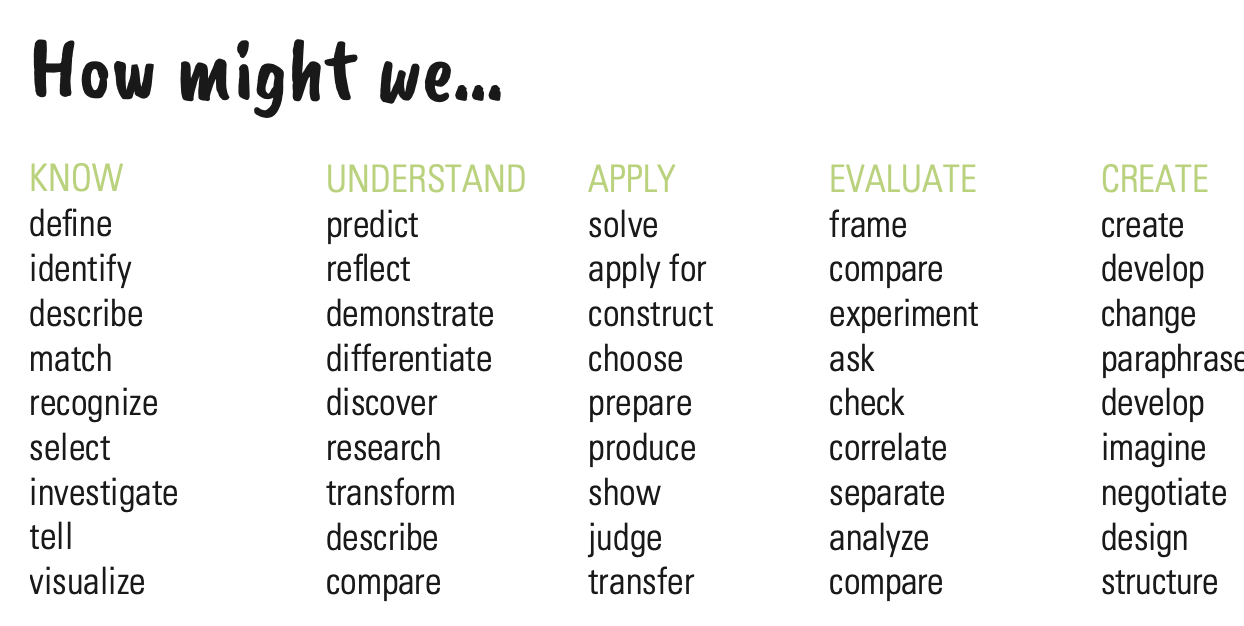1
Defining Problem Statement “How Might We…”
Defining Problem Statement “How Might We…”
Innhold
In the Define stage of Human-Centered Design Thinking, we turn what we’ve learned through empathy into a focused challenge we want to address. This means identifying the real needs behind what people say or do—and framing them in a way that sparks creative solutions.
One of the most powerful tools for this is the “How Might We…” question. It helps us reframe problems as open-ended opportunities. In youth work, this step is essential: young people’s realities are diverse and complex, and good problem framing ensures we’re working on the right challenge—not just the most obvious one.
The define mode is when you unpack your empathy findings into needs and insights and scope a meaningful challenge. Based on your understanding of users and their environments, come up with an actionable problem statement.
When clear statements are there, then ‘How might we…” method will help moving into the right direction of ideating solutions:
- "How" suggests that we do not yet have the answer.
- "Might” empathises that there are many different paths that we can go down, not the only solution.
- "We" immediately brings in the element of collaboration and teamwork.
Practice: use the attached template to build your HWM statement.
Some of these words might help you to start your statement based on previoulsy done "Empathise" phase outcomes

Pro Tip
There is no right or wrong way to create a “How Might We” (HMW) question.
- Trust your instinct to decide if the question matches the problem statement.
- If it fits well, you’ll feel motivated to generate ideas. If not, it’s usually hard to think of any ideas.
- It’s often more effective to prepare several HMW questions for a topic rather than debating the perfect wording.
- Each question can be treated like a prototype and tested in a short brainstorming session.
- The one that works best can then be developed further.
Source: Google Design Sprint Kit: https://designsprintkit.withgoogle.com/methodology/overview
Watch "User Needs Statement in Designing Thinking"
Source: NNgroup Youtube channel
How to work on problem statement in the team?
- Start with a clear challenge or problem you want to address.
- Break down the main challenge into smaller challenges or facets.
- Motivate the project development team to come up with several “How might we...” (HMW) questions that address the identified needs or opportunity field.
- For each facet, begin by writing "How might we..." followed by the challenge in question form. E.g., "How might we promote inclusivity in our youth project?"
- Each question should adhere to the logic of “How might we...” followed by a verb (e.g. develop), a noun (e.g. a set of tools), and the type of ‘user’ (e.g. young people in rural areas).
- Each participant writes their "How might we..." questions on post-it notes.
- Read the"How might we..." question aloud and ask if the team is inspired by the question to find many solutions. If not, the question might be too narrow or the HMW question is too broad.
To deal with this dilemma, there are two question techniques: “WHY (should it be done)” in order to expand the focus and “HOW,” in order to narrow down the focus of consideration.
6. Cluster similar questions together on the whiteboard.
7. Prioritise the questions based on importance or feasibility.
8. Begin brainstorming solutions for the top prioritised questions.
To earn the Open Badge for this activity, share one “How Might We” statement you helped create and explain what makes it meaningful or inspiring to you. Use the attached template to build your HWM statement and you can upload it to the badge.
This activity is part of the KA2 Cooperation Partnership project Learn INN, supported by the European Union’s Erasmus+ programme.
Author of the activity: Laimonas Ragauskas, inspiration by IDEO, NNgroup, Design Thinking
Bootleg of d.school at Stanford.
Last ned aktivitetsmerke
Defining Problem Statement “How Might We…” Få dette merket
I earned this badge by learning how to define challenges in a clear and open way using “How Might We” statements. I practised turning insights from empathy work into opportunities for innovation, showing creativity and the ability to focus on what truly matters. I contributed to shaping problems that invite new ideas and collaborative solutions.
This badge is part of the KA2 Cooperation Partnership project Learn INN, supported by the European Union’s Erasmus+ programme.
Oppgaver
Oppgavenr.1
Bevis bekreftet av: en aktivitetsarrangør
Share one “How Might We” statement you helped create and explain what makes it meaningful or inspiring to you.
(Write a short explanation or upload a visual if you prefer.)
Ferdigheter
#Aiming at reaching educational aims by using specific ways and methods that encourage creativity, problem solving, ‘out-of-the-box’ thinking, in different environmental aspects
ETS-TR
#Facilitates problem solving
Arrangører
Awero
Badge issuer recognized with
Endre til annet språk:
